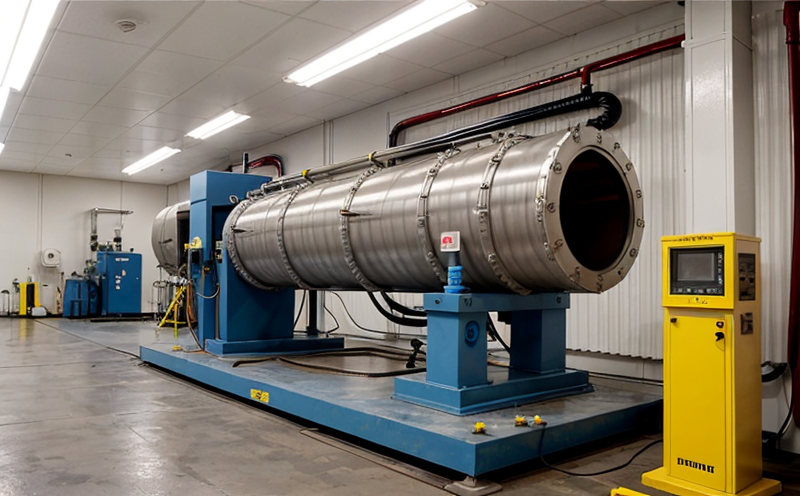ISO 15709 Uranium Dioxide Pellet Density Testing
The ISO 15709 standard provides a detailed methodology for testing the density of uranium dioxide (UO2) pellets. This is crucial in ensuring that nuclear fuel meets stringent quality and safety standards, which are paramount to the operation of nuclear reactors.
Uranium dioxide is a key component used in fabricating fuel elements for nuclear power plants. Its density can significantly impact the performance and efficiency of these fuels. Variations in density could lead to discrepancies in the mass balance calculations, affecting reactor performance and safety. Therefore, accurate determination of UO2 pellet density is critical.
The ISO 15709 standard mandates a specific procedure that involves determining the weight and volume of individual pellets to calculate their density. This process ensures that each pellet meets the required specifications set by international standards. The standard also provides guidelines for sample preparation, equipment calibration, and data interpretation to minimize errors.
One of the primary challenges in this testing is ensuring that the pellets are homogeneous and free from voids or defects. Non-homogeneous materials can lead to inaccurate density readings, which could misrepresent the actual performance of the fuel. Additionally, the presence of impurities can also affect the accuracy of the test results. Therefore, rigorous quality control measures must be implemented during sample preparation.
The testing procedure outlined in ISO 15709 is designed to minimize these challenges by providing a standardized approach. This includes using calibrated equipment and adhering strictly to prescribed procedures for sample handling and measurement. By following these guidelines, laboratories can ensure that their test results are reliable and consistent with international standards.
The importance of this testing cannot be overstated, especially given the critical role uranium dioxide plays in nuclear fuel fabrication. Accurate density measurements are essential not only for quality control but also for ensuring compliance with safety regulations and performance criteria set by regulatory bodies such as the International Atomic Energy Agency (IAEA).
Scope and Methodology
The scope of ISO 15709 Uranium Dioxide Pellet Density Testing is focused on providing a comprehensive methodology for determining the density of UO2 pellets. This includes detailed instructions for sample preparation, measurement techniques, and data analysis. The methodology ensures that each step in the testing process adheres to internationally recognized standards, thereby enhancing the accuracy and reliability of the results.
The key components of this method include:
- Determining the weight of individual pellets using precision scales
- Measuring the volume of the pellets by submerging them in a liquid and recording the displacement
- Data analysis to calculate density based on the mass-volume relationship
The methodology is designed to be robust, reproducible, and adaptable to different laboratory environments. It also emphasizes the importance of calibration and validation of equipment to ensure consistent results.
| Step | Description |
|---|---|
| Determining weight | Pellets are placed on precision scales calibrated according to ISO standards. |
| Measuring volume | The pellets are submerged in a liquid of known density, and the displacement is measured accurately. |
| Data analysis | The mass and volume data are used to calculate density using the formula: Density = Mass / Volume. |
Calibration of equipment is critical for accurate results. Regular checks against known standards ensure that any variations in measurement can be attributed to environmental factors or human error rather than instrument malfunction.
Industry Applications
The ISO 15709 standard finds extensive application across various sectors, particularly where uranium dioxide is used. These include nuclear fuel fabrication plants, research institutions, and regulatory bodies responsible for overseeing the safety and performance of nuclear reactors.
- Nuclear power generation: Ensuring that the fuel pellets meet stringent density requirements enhances reactor efficiency and safety.
- Research and development: Accurate testing is essential for developing new fuel formulations and improving existing processes.
- Regulatory compliance: Laboratories must adhere to international standards to ensure their tests are valid and reliable, thereby complying with regulatory bodies' mandates.
| Sector | Description |
|---|---|
| Nuclear Power Generation | Ensuring that fuel pellets meet density requirements is crucial for reactor performance and safety. |
| Research Institutions | Accurate testing aids in the development of new fuel formulations and process improvements. |
| Regulatory Bodies | Compliance with international standards ensures that tests are valid and reliable, enhancing overall safety. |
Use Cases and Application Examples
The use cases for ISO 15709 Uranium Dioxide Pellet Density Testing are diverse but all center around ensuring the quality and consistency of nuclear fuel. Some specific examples include:
- Daily quality checks in a nuclear fuel fabrication plant to ensure that each batch of pellets meets the required density.
- Pre-production testing at research institutions to validate new fuel designs before full-scale production.
- Post-manufacture testing by regulatory bodies to verify compliance with international standards and safety regulations.
| Use Case | Description |
|---|---|
| Daily Quality Checks | A laboratory performs density tests on a sample of pellets produced each day to ensure consistency in quality. |
| Pre-Production Testing | A research institution conducts testing on experimental fuel designs to validate their performance before mass production. |
| Post-Manufacture Testing | Regulatory bodies verify compliance with international standards and safety regulations after the pellets are manufactured. |
In each of these scenarios, accurate density testing is essential for ensuring that nuclear fuel meets the highest quality standards. This not only enhances reactor performance but also ensures the safety and reliability of nuclear power generation.





